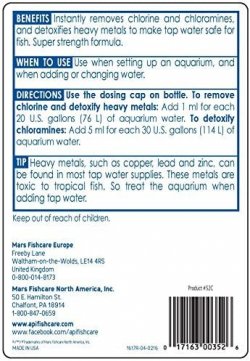In the nearly 10 years I have kept fish, I have always used Seachem Prime for weekly water changes, with fine results.
After reading several comments here stating that the API TWC works just as well, and is more concentrated ("1 ml treats 20 USG") than the Prime, I was going to switch to the API TWC...until I read the directions for the API...see attached
My tap water contains chloramines, not chlorine, so the dosage I would have to use with the API would be MORE than I am now dosing with the Prime, which is 1 ml/10 USG. (The API dosage for tap water containing chloramine is 5 ml per 30 USG, as noted on the label below).
For those of you who DO use the API TWC, this makes it important to know whether your tap water is treated with chlorine or chloramine, which I did not know until now.
The directions for the Prime do not differentiate between chlorine and chloramine, the dosage remains the same.
There has been some discussion on the forums lately about the effectiveness of Prime, what it purports to do, and what it's effectiveness may actually be or not be; this discussion is merely for dosage amounts, only.
After reading several comments here stating that the API TWC works just as well, and is more concentrated ("1 ml treats 20 USG") than the Prime, I was going to switch to the API TWC...until I read the directions for the API...see attached
My tap water contains chloramines, not chlorine, so the dosage I would have to use with the API would be MORE than I am now dosing with the Prime, which is 1 ml/10 USG. (The API dosage for tap water containing chloramine is 5 ml per 30 USG, as noted on the label below).
For those of you who DO use the API TWC, this makes it important to know whether your tap water is treated with chlorine or chloramine, which I did not know until now.
The directions for the Prime do not differentiate between chlorine and chloramine, the dosage remains the same.
There has been some discussion on the forums lately about the effectiveness of Prime, what it purports to do, and what it's effectiveness may actually be or not be; this discussion is merely for dosage amounts, only.
Attachments
Last edited:


